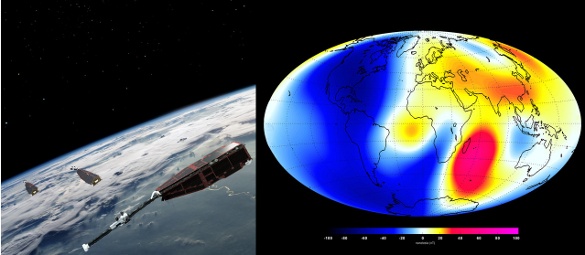Geomagnetic Reversal
July 21, 2014
Humans have known about
magnetism for
millennia. In the
sixth century B.C., the
Greek philosopher,
Thales, wrote about the attraction of
lodestones. Lodestones are magnetized specimens of the mineral,
magnetite (Fe
3O
4), and these stones are attracted to themselves, and to
iron. The
compass, also known from antiquity, demonstrated the existence of
Earth's magnetic field.
As I wrote in a
previous article (Magnetic Mars, April 15, 2013), the
English scientist,
William Gilbert, published the 1600
book,
De Magnete, which was the first
modern study of magnetism.[1] Gilbert created a
sphere of lodestone, which he called a
terrella, as a
model to provide evidence that the
Earth was a giant magnet. A compass placed on its surface acted as a compass does on
magnet.

William Gilbert (1544-1603)
I went to high school with a girl whose last name was Gilbert. If I had known about William Gilbert at the time, I would have asked whether she might have been from the same family.
The gilbert, a unit of magnetomotive force, was named in his honor. The gilbert is a cgs unit, not an SI unit.
(Gilbert portrait by Charles Henry Granger (1812-1893), via Wikimedia Commons.)
The Earth's magnetic field, which ranges from 0.25 to 0.65
gauss when measured at its surface, is thousands of time less than that of a
barium ferrite (BaFe
12O
19), the magnetic component of
refrigerator magnets. The Earth's magnetic field may be small, but it's significant, since it deflects
cosmic rays around the Earth.
A magnetic field will deflect a moving
charged particles according to the "
left-hand rule" taught during introductory
physics courses. This rule concerns
electrical current, but a moving
charge is an electrical current. This deflection of charged particles has been important to the Earth, since it's prevented the
solar wind from stripping away our
atmosphere.
Mars, with no global magnetic field, wasn't as lucky.
So, how stable has Earth's magnetic field been? On average, very good, with one notable feature. Since the Earth's magnetic field is apparently generated by a
dynamo action of liquid iron in the core, it's subject to the whims of
hydrodynamics. This includes spontaneous reversals of the
fluid flow; and, in Earth's case, a spontaneous reversal of the
magnetic polarity.
This means that
compass needles would point
south instead of
north. As strange as they might sound, these
geomagnetic reversals have happened often in
Earth's history. As the figure shows, we've been in an extended period of our present polarity.

Geological record of magnetic reversals. The blue periods are those with our present, compass needles pointing North, polarity. Short-term field flips, such as the 440 year Laschamp reversal event, 41,000 years ago, occur within the extended periods shown. (Data from U.S. Geological Survey Open-File Report 03-187, via Wikimedia Commons, modified for clarity.)
Do bad things happen during such field reversals?
Scientists have found no
extinction events, and they have determined that the Earth's magnetic field decreased by just 5% during the short (440
year)
Laschamp reversal event that occurred 41,400 ± 2,000 years ago.[2]
To more closely study Earth's magnetic field, the
European Space Agency has launched its
Swarm constellation of three identical
satellites, two of which are in an initial 460
km orbit, and the third is in a higher, 530 km orbit. The orbits are designed to optimize
measurement accuracy. The first observations were presented at the
Third Swarm Science Meeting,
Copenhagen,
Denmark, on June 19, 2014.[3-4]
Six months of observations have shown a weakening of Earth's field over the
Western Hemisphere, a field increase at the southern
Indian Ocean, and a migration of the North magnetic pole towards
Siberia (see figure).[3] These
data may indicate an imminent geomagnetic reversal, imminent meaning the usual timescale for such a reversal, hundreds of years.[3-4]

Left, the ESA Swarm satellite constellation. Note that the magnetometers are attached to long booms to distance them from the magnetic influence of the satellite body. The right image shows changes in the Earth's magnetic field from January to June, 2014, with red indicating an increase and blue indicating a decrease. Click for larger map image. (left image, Copyright ESA/AOES Medialab; right image, Copyright ESA/DTU Space.)[3)]
These field changes are an
order of magnitude greater than a previous estimate of five percent per
century. Now, it's more like 5% per decade. The Sawrm data are expected not only to generally characterize Earth's field, but also as a means to
predict earthquakes.[4] I wrote about earthquake prediction in some previous articles (
A Century of Earthquake Prediction Possibilities, October 4, 2013 and
Earthquake Prediction, January 16, 2013).
References:
- William Gilbert, "De Magnete," 1600 (original Latin) English translation. The illustration is from Book III, Chapter XII.
- N.R. Nowaczyk, H.W. Arz, U. Frank, J. Kind, and B. Plessen, "Dynamics of the Laschamp geomagnetic excursion from Black Sea sediments," Earth and Planetary Science Letters, Vols. 351-352 (October 15, 2012), pp. 54-69
- Swarm reveals Earth's changing magnetism, ESA Press Release, June 19, 2014.
- Kelly Dickerson, "Earth's Magnetic Field Is Weakening 10 Times Faster Now," Live Science, July 8, 2014.
- ESA's magnetic field mission Swarm, Europeasn Space Agency.
- Swarm fact sheet (PDF File).
Permanent Link to this article
Linked Keywords: Magnetism; millennium; millennia; 6th century BC; sixth century B.C.; ancient Greek philosophy; Greek philosopher; Thales; lodestone; magnetite; iron; compass; Earth's magnetic field; English; scientist; William Gilbert; book; De Magnete; modern; sphere; terrella; physical model; Earth; magnet; high school; family; magnetomotive force; cgs unit; SI unit; Charles Henry Granger (1812-1893); Wikimedia Commons; gauss; barium ferrite; refrigerator magnet; cosmic ray; electric charge; particle; left-hand rule; physics; course; electrical current; solar wind; atmosphere of Earth; Mars; dynamo theory; dynamo action; fluid dynamics; hydrodynamics; fluid flow; magnetic polarity; compass needle; south; north; geomagnetic reversal; geologic time scale; Earth's history; geological record; Laschamp event; U.S. Geological Survey; Open-File Report 03-187; scientist; extinction event; year; European Space Agency; Swarm mission; satellite constellation; satellite; kilometer; km; orbit; measurement accuracy; Third Swarm Science Meeting; Copenhagen; Denmark; Western Hemisphere; Indian Ocean; Siberia; data; magnetometer; order of magnitude; century; prediction; predict; earthquake; William Gilbert, "De Magnete," 1600.